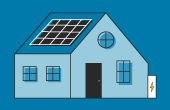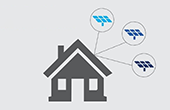We have been 99% self-powered since the day we flipped the switch, but we still have the grid if needed.
$1,228
$14,433
8.5%
Property
- Owner:
- steve jackson
- Type:
- Residential
- Address:
- 2229 Blueberry Street, Belmont, NC 28012
- Size:
- 1,330 sq ft
Technology
- Type:
- Solar PV
- Installed:
- April 2023
- Size of System:
- 7.2 kW
- Purposes:
- To generate electricity
Financial Details
- Gross Cost of System:
- $20,619
- Value of Tax Credits:
- $6,186
- Net Cost of System:
- $14,433
- Annual Savings:
- $1,228
- Own or Lease:
- Cash Purchase
- Additional Financial Notes:
- We have only been on the new system for less than a month, so it's not possible to confirm the value of net metering. We paid cash instead of financing.
Professionals & Suppliers
- Installers:
- Firefly Solar & Roofing
What You Need to Know
Description:
We have 19 Trina Energy solar panels on our south-facing roof, connected via EnPhase micro-inverters to the Tesla Gateway and PowerWall battery. The battery smooths out the available solar power so that we almost never draw from Duke Energy, but once the battery is fully charged, our excess is sent to the grid for "net-metering" credit.
Maintenance Requirements:
We are not expecting the system to require any maintenance, as all the parts are designed for outdoor use.
My Motivation:
1 - we had several, infrequent but extended, power outages in the last year. We wanted to provide backup power for health-related items as well as refrigeration and heat. 2 - wanted to reduce the burning of coal or natural gas for the electrical power we use.
Advice:
Solar PV panels produce DC power, which must be converted to AC power to be used in the typical house, but the conversion is inefficient, wasting 10% or so of the power produced. Our system then must convert AC back to DC to charge the battery. Some battery systems accept DC power directly from the PV panels, which could result in a 10% power saving.
Experience with Installer:
The Firefly Solar installers were all friendly and knowledgeable, all spoke English well, and cleaned up after their work. There is a lot of electrical work to be done to interface the existing home power feed from the grid with the "gateway" and other components. This took 2 days to complete, and required an inspection from our county. The Solar Panel installation on the roof was completed in one day, while the electrician was completing Day 2 tasks, but they discovered a couple of the inverters were not "reporting" to the system, so they came back the second day to reconnect the wiring on the roof, and get them working properly. The longest delay was waiting for our county electrical inspector to approve the work, as they do not communicate their schedule to anyone outside their office, and just show up unannounced. Duke Energy was prompt in providing their approval for our system, within 2 days of the request.
Additional Notes:
The Tesla phone app to monitor the PowerWall has made us very much more aware of the cost of running our major appliances - electric clothes dryer, our Plug-in Hybrid car charger, the microwave and air fryer, etc. We now try to use those appliances primarily in morning or early afternoon, so that we can power them from incoming solar energy, and not deplete the PowerWall battery, which is our "backup" solution for power-grid failures as well. Of course, the air conditioner will need to run when the house gets hot, so we may find more "grid power" creeping into the mix as summer progresses.
View Other Case Studies
Search for Other Case StudiesThe EnergySage Marketplace





